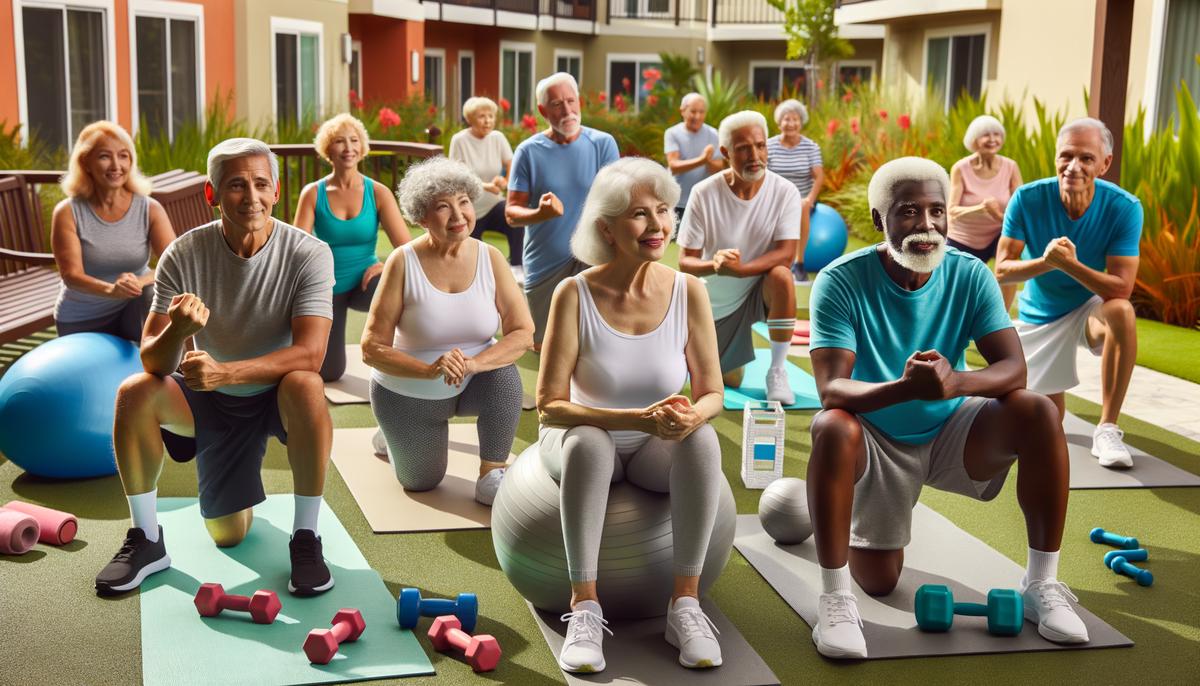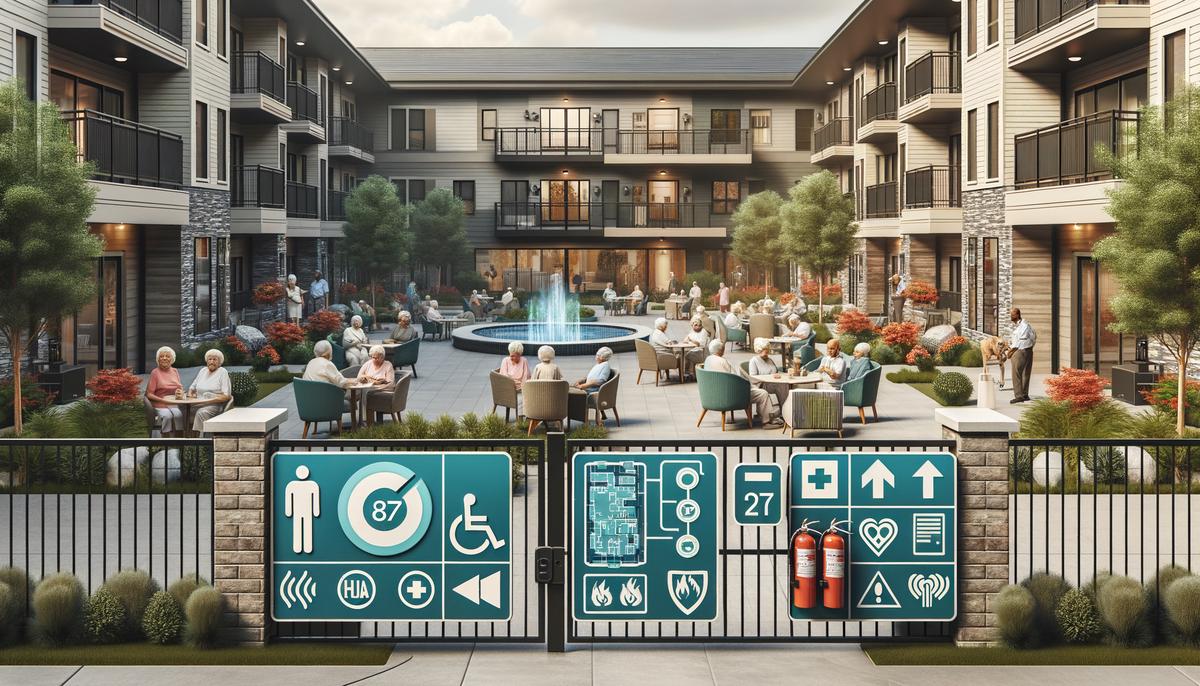As we explore the world of senior living communities, it’s essential to understand the broad spectrum of benefits these environments offer to older adults. This article will delve into how these communities significantly enhance the physical, mental, and social well-being of their residents while ensuring unparalleled safety and peace of mind. Through a closer look at their comprehensive services and programs, we will see how senior living communities are not just places to live, but places where seniors can thrive.
Physical Health Benefits
When considering senior living communities, one of the most important aspects to look into is how they can improve a resident’s physical health. Senior living communities are specifically designed to cater to the health and wellness needs of older adults, offering a variety of programs and facilities to keep residents both happy and healthy.
At the core of these communities are fitness centers equipped with age-appropriate equipment and staffed by professionals trained in geriatric fitness. Residents can participate in group exercise classes like yoga, tai chi, and water aerobics, which are not only great for the body but also provide an opportunity to socialize and connect with fellow residents. These classes focus on enhancing flexibility, balance, and strength, which are crucial for preventing falls—a common concern for aging individuals.
Nutrition is another pillar of physical health that senior living communities pay close attention to. Dining services provide well-balanced meals crafted by nutritionists to meet the dietary needs of seniors. These meals ensure that residents receive the right mix of vitamins and minerals to keep their bodies strong and healthy. Some communities even offer nutrition lectures and cooking demonstrations to educate residents about healthy eating habits and how to prepare nutritious meals.
Preventive health care services in these communities play a pivotal role in maintaining residents’ well-being. Many have on-site health clinics where residents can receive regular check-ups, vaccinations, and monitoring for chronic conditions. This accessibility to healthcare services ensures that potential health issues can be caught and addressed early before they escalate into more serious problems.
Moreover, senior living communities often encourage outdoor activities, like gardening or walking clubs, taking advantage of landscaped grounds and walking paths. Engaging in outdoor activities not only benefits physical health through exercise but also boosts mental health by connecting with nature and enjoying fresh air.
Senior living communities recognize the importance of physical activity and offer a structured environment that motivates residents to stay active. With various exercise classes, nutritional plans, preventive healthcare, and outdoor activities, these communities provide an all-encompassing approach to enhance the physical health of their residents. This supportive environment makes it easier for seniors to focus on their health and enjoy their golden years with the peace of mind that their physical well-being is in good hands.

Mental Health and Social Engagement
Turning our attention to the significance of mental health and social engagement in senior living communities, it’s clear that these aspects are just as crucial as physical health for the overall well-being of older adults. Senior living communities are increasingly recognizing the importance of fostering both mental acuity and social connections, integrating various programs and services designed to support these vital areas of residents’ lives.
Firstly, senior living communities often provide activities aimed at keeping the mind sharp, such as book clubs, puzzles, and brain games. These activities not only entertain but also stimulate cognitive functioning, which is key in combating the onset of dementia and other age-related cognitive declines. Furthermore, many communities offer educational sessions and workshops that allow residents to learn new skills or deepen their knowledge in certain areas, thereby continually challenging and engaging their minds.
Social engagement is another cornerstone of mental health support in senior living communities. Loneliness and isolation can have detrimental effects on seniors’ mental health, potentially leading to depression and decreased physical health. To combat this, senior living communities place a strong emphasis on creating opportunities for residents to connect and share experiences. From social events, shared meals in communal dining areas to group outings, these activities provide residents with the sense of community and belonging that is essential for their emotional well-being.
Another aspect worth mentioning is the role of spiritual wellness programs in supporting mental health. Many communities offer meditation, yoga, and other spiritual or religious services that cater to the diverse needs of their residents. These practices can offer solace, reduce stress, and enhance residents’ overall sense of peace and well-being.
The integration of technology has also played a pivotal role in promoting mental health and social engagement. Senior living communities are increasingly utilizing digital platforms to facilitate communication among residents and their families, especially important for those who may have mobility issues or live far from their loved ones. Video calls, social media, and other online tools enable residents to stay connected with the outside world, thereby supporting their mental health and reducing feelings of isolation.
In terms of support for residents with specific mental health needs, many senior living communities are equipped to provide specialized care. This includes access to mental health professionals who can offer therapy and counseling, creating a safe space for residents to discuss their feelings and challenges. Moreover, some communities have bespoke programs designed for residents with Alzheimer’s disease and other forms of dementia, providing a structured environment that supports their unique needs while promoting their independence as much as possible.
In conclusion, senior living communities play a pivotal role in supporting not just the physical, but also the mental and social well-being of their residents. Through a variety of programs, services, and initiatives, these communities strive to create an enriching, supportive environment where older adults can thrive in their golden years. By focusing on mental health and social engagement alongside physical health, senior living communities ensure a holistic approach to the care and well-being of their residents, acknowledging the complex interplay between the body, mind, and spirit in achieving overall health.

Safety, Security, and Peace of Mind
In the quest to provide unparalleled safety and peace of mind for residents, senior living communities go above and beyond to integrate comprehensive security measures and emergency preparedness protocols. Recognizing the paramount importance of feeling secure in one’s environment, these communities invest heavily in state-of-the-art safety infrastructure and tailored procedures to address the unique needs of senior residents.
Security is a cornerstone of these communities, starting with controlled access points to ensure that only authorized individuals enter the premises. This includes the installation of secure gates, door access codes, and even biometric systems in some of the more advanced facilities. The presence of surveillance cameras strategically placed around the property acts as a deterrent against unauthorized entry and provides a digital record of activities, enhancing the sense of security among residents and their families.
Emergency preparedness is another critical component, with senior living communities developing detailed response plans tailored to a variety of scenarios. Fire safety measures are rigorously implemented, including smoke detectors in each residence, regular fire drills, and easy access to fire extinguishers. Many communities also have sprinkler systems throughout the property to contain fires swiftly should they arise.
Moreover, staff members receive extensive training in emergency response, ensuring they are prepared to act swiftly and effectively in any situation. This includes training in CPR, first aid, and the use of automated external defibrillators (AEDs). Regular drills are conducted to keep the staff’s skills sharp and to ensure that emergency procedures are second nature, should the need ever arise.
In addition to these universal safety measures, personalized care plans play a crucial role in providing peace of mind. Each resident’s health and mobility level are carefully assessed to create a personalized emergency response plan. For those with specific medical needs, such as residents with a history of falls, additional precautions may include wearable emergency alert devices that allow them to summon help with the push of a button.
Many senior living communities also maintain close relationships with local emergency services, ensuring a rapid response in the event of a health emergency or natural disaster. Some have even established on-site health facilities staffed by medical professionals to provide immediate care when needed.
Communication is key to maintaining a safe environment. Residents and their families are regularly updated on safety protocols and emergency procedures. These communities often employ user-friendly technology, such as apps or online platforms, to facilitate clear and immediate communication with residents and their loved ones. This ensures that everyone is informed and prepared, further reinforcing the sense of security within the community.
By weaving together advanced security technology, comprehensive emergency preparedness, personalized care plans, and transparent communication, senior living communities are able to provide a safe haven for residents. This multi-faceted approach not only addresses the physical safety of residents but also supports their psychological well-being, offering the invaluable peace of mind that comes from knowing one is well-cared for in a secure and nurturing environment.

Senior living communities stand as a testament to a comprehensive approach to wellness for older adults, seamlessly integrating physical health, mental vigor, social connections, and safety into everyday life. These communities go beyond mere accommodation, offering a nurturing space where seniors can enjoy their golden years with confidence and joy. With each aspect thoughtfully catered to, residents and their families can rest assured that life in these communities is about maintaining independence, building meaningful relationships, and ensuring a high quality of life amidst a safe and supportive environment.
Experience the magic of Writio – the ultimate AI content writer! This post was crafted by Writio.
Leave a Reply